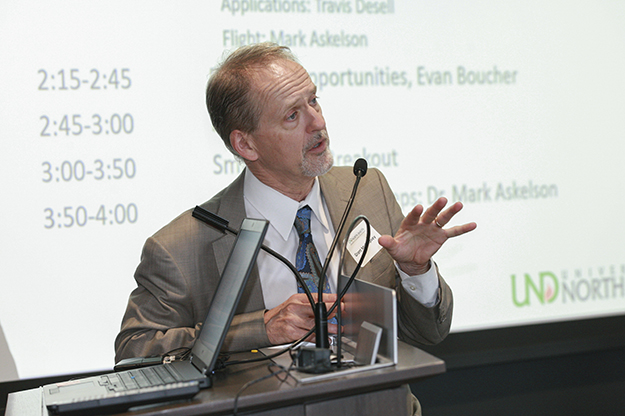Research on the record
UND division creates better system of reporting and directing research investments

Research innovation takes many forms.
The University of North Dakota’s leaders in action are discovering ways to slow opioid addiction, to retrieve more energy from North Dakota’s oilfields, and to push UAS possibilities further than ever before.
But often a University’s exploration enterprise comes down to dollars and cents – and UND is now making better sense of those dollars.
In this year’s Higher Education Research and Development Survey (HERD), an annual report submitted to the National Science Foundation, UND will show a sharp increase in research expenditures for Fiscal Year 2017 (FY17).
In FY16, UND reported research expenditures – external and internal funding spent to conduct research, scholarship and creative activities – totaling roughly $70 million. For FY17, that number was more than $100 million.
But Grant McGimpsey, vice president for research & economic development (VPRED), says the spike isn’t a case of UND spending significantly more money on research. UND is simply being more comprehensive about how it categorizes and records its robust efforts.
“The reason we are making a change in reporting – which has been approved by HERD staff and better aligns with reporting by other universities – is solely to better understand how we are investing the University’s resources,” McGimpsey said.
McGimpsey, who serves as captain of the One UND Strategic Plan’s Goal 4 (enhancing discovery), has enlisted a team to find areas of improvement for not only sharing this data, but also collecting it in the first place.
“I’m thrilled with the energy Grant and his office have put into improving the accuracy of how we report the society-changing work of our faculty and students,” UND Provost Tom DiLorenzo said.
“As we further refine our system of assessing and documenting how our research dollars are spent, UND will be able to make more targeted, mindful investments for the future,” added UND President Mark Kennedy. “That’s how our University will best serve its students, and how it will help address the state’s challenges.”

Why the difference?
McGimpsey says there are three reasons why the numbers are different between FY16 and FY17.
First, UND had an increase in externally funded expenditures last year (approximately $3 million), through one-time and continuing awards from federal funding agencies (e.g., National Institutes of Health), state agencies (e.g., Research North Dakota), industry, foundations and private donations.
Second, UND’s colleges and departments are more accurately accounting for the research expenditures that they’ve been making, but haven’t necessarily been reporting centrally.
Finally, the office of the VPRED has identified some categories that the HERD survey measures, but UND hasn’t been reporting in the past. For example, the University hadn’t included tuition waivers for some graduate assistants involved in research, nor had it included the percentage of faculty salary and benefits assigned to research in their contracts. A system has now been established to make that percentage clearer and more easily measured.
“We haven’t substantially increased the amount that the University is spending on research,” McGimpsey said. “It’s an expense that we’ve always had, we just haven’t had the systems in place to report it in the past.”
That said, UND has made available about an additional $2 million per year to support research through competitive seed award programs over the past two years. All told, UND spends more than $35 million to support research across the University.
“Ultimately we want to use these internal investments to drive more success in obtaining external funding,” McGimpsey said, adding that UND currently sees a 2-to-1 ratio of external/internal dollars. “We’d like that ratio to be 4-to-1.”
Strategic spending
Now that McGimpsey’s team has a better understanding of what the University has been spending, they can get a better handle on the return on investment – specifically, what the state of North Dakota has to gain.
UND isn’t expecting to spend less on research. But it is trying to concentrate its expenses on the Strategic Plan’s Grand Challenges – areas of state and societal need such as medicine, energy, rural communities and unmanned and autonomous systems.
These research areas are among the most actively growing on campus, and McGimpsey wants to make sure that faculty in all disciplines can play a role in their development. He’s calling on the university community to help further define its Grand Challenges, engage with the Grand Challenge teams and collaborate to help drive solutions.
“I’m excited that we have spent and will continue to spend substantially on supporting research,” McGimpsey said. “I’m also excited by the opportunity to focus our investments in these areas of state and national need. You always get more bang for your buck when you are able to focus.”
Research cycle
Establishing a more accurate method of accounting for internal research expenditures is a first step in a process to drive greater research activity. This knowledge helps colleges set aggressive but realistic targets for future expenditures. At the same time, McGimpsey says, UND must understand and measure research and scholarly productivity.
To make this easier, a new, simplified Digital Measures will roll out later this spring.
The updated Digital Measures system will give faculty a more condensed list of categories to choose from when documenting and reporting research and scholarly products. The research office is producing an online tutorial and will be demonstrating the platform at department meetings.
“This is the research cycle,” McGimpsey said. “We make investments, we assess the outcomes, and we fine-tune the investments based on our productivity. Each dean or chair may have different goals for productivity, but now they’ll know what they’re investing in and what they’re getting.”
There’s much more to be done to hit the five-year targets of the Strategic Plan, but the University now has its aims aligned.
“It will take all programs and disciplines working together to bring UND’s already strong research engine to the next level,” President Kennedy said. “These efforts are the foundation that will get us there.”


